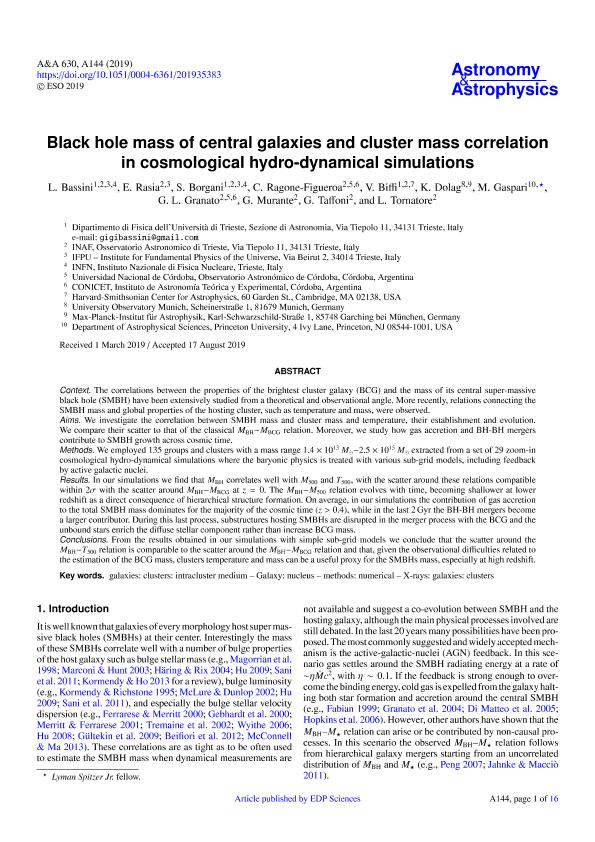Artículo
Black hole mass of central galaxies and cluster mass correlation in cosmological hydro-dynamical simulations
Bassini, L.; Rasia, E.; Borgani, S.; Ragone Figueroa, Cinthia Judith ; Biffi, V.; Dolag, K.; Gaspari, M.; Granato, Gian Luigi; Murante, G.; Taffoni, G.; Tornatore, L.
; Biffi, V.; Dolag, K.; Gaspari, M.; Granato, Gian Luigi; Murante, G.; Taffoni, G.; Tornatore, L.
 ; Biffi, V.; Dolag, K.; Gaspari, M.; Granato, Gian Luigi; Murante, G.; Taffoni, G.; Tornatore, L.
; Biffi, V.; Dolag, K.; Gaspari, M.; Granato, Gian Luigi; Murante, G.; Taffoni, G.; Tornatore, L.
Fecha de publicación:
10/2019
Editorial:
EDP Sciences
Revista:
Astronomy and Astrophysics
ISSN:
0004-6361
e-ISSN:
1432-0746
Idioma:
Inglés
Tipo de recurso:
Artículo publicado
Clasificación temática:
Resumen
The correlations between the properties of the brightest cluster galaxy (BCG) and the mass of its central super-massive black hole (SMBH) have been extensively studied from a theoretical and observational angle. More recently, relations connecting the SMBH mass and global properties of the hosting cluster, such as temperature and mass, were observed. Aims. We investigate the correlation between SMBH mass and cluster mass and temperature, their establishment and evolution. We compare their scatter to that of the classical MBH-MBCG relation. Moreover, we study how gas accretion and BH-BH mergers contribute to SMBH growth across cosmic time. Methods. We employed 135 groups and clusters with a mass range 1.4 × 1013 M⊙- 2.5 × 1015 M⊙ extracted from a set of 29 zoom-in cosmological hydro-dynamical simulations where the baryonic physics is treated with various sub-grid models, including feedback by active galactic nuclei. Results. In our simulations we find that MBH correlates well with M500 and T500, with the scatter around these relations compatible within 2σ with the scatter around MBH - MBCG at z = 0. The MBH - M500 relation evolves with time, becoming shallower at lower redshift as a direct consequence of hierarchical structure formation. On average, in our simulations the contribution of gas accretion to the total SMBH mass dominates for the majority of the cosmic time (z > 0.4), while in the last 2 Gyr the BH-BH mergers become a larger contributor. During this last process, substructures hosting SMBHs are disrupted in the merger process with the BCG and the unbound stars enrich the diffuse stellar component rather than increase BCG mass. Conclusions. From the results obtained in our simulations with simple sub-grid models we conclude that the scatter around the MBH - T500 relation is comparable to the scatter around the MBH - MBCG relation and that, given the observational difficulties related to the estimation of the BCG mass, clusters temperature and mass can be a useful proxy for the SMBHs mass, especially at high redshift.
Archivos asociados
Licencia
Identificadores
Colecciones
Articulos(IATE)
Articulos de INST.DE ASTRONOMIA TEORICA Y EXPERIMENTAL
Articulos de INST.DE ASTRONOMIA TEORICA Y EXPERIMENTAL
Citación
Bassini, L.; Rasia, E.; Borgani, S.; Ragone Figueroa, Cinthia Judith; Biffi, V.; et al.; Black hole mass of central galaxies and cluster mass correlation in cosmological hydro-dynamical simulations; EDP Sciences; Astronomy and Astrophysics; 630; 10-2019; 1-16
Compartir
Altmétricas



